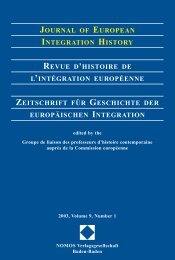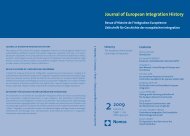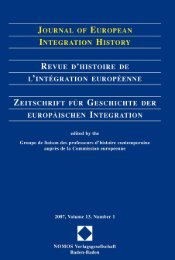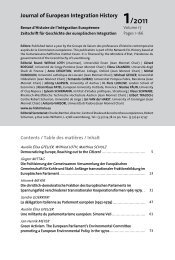journal of european integration history revue d'histoire de l ...
journal of european integration history revue d'histoire de l ...
journal of european integration history revue d'histoire de l ...
You also want an ePaper? Increase the reach of your titles
YUMPU automatically turns print PDFs into web optimized ePapers that Google loves.
66<br />
Tapani Paavonen<br />
ment prohibited, <strong>of</strong> course, foreign tra<strong>de</strong> regulations on products subject to the agreement.<br />
The agreement inclu<strong>de</strong>d, however, the same reservations than FINN-EFTA for<br />
import regulations on fossil fuels and phosphate and potassium fertilisers, in or<strong>de</strong>r to<br />
secure Finland's Eastern tra<strong>de</strong>. 21<br />
V. The Question <strong>of</strong> the European Economic Space/Area<br />
The extension <strong>of</strong> EFTA-EC cooperation beyond mere free tra<strong>de</strong> was discussed,<br />
especially within EFTA, from 1977 onwards. Eventually, the mid-1980s marked a<br />
completely new stage in Finland's relationship with the West European <strong>integration</strong>.<br />
Since then Finland's position too shifted away from mere free tra<strong>de</strong> on industrial<br />
goods to an all-embracing <strong>integration</strong>, albeit the new orientation materialised only<br />
a <strong>de</strong>ca<strong>de</strong> later.<br />
The Luxembourg Declaration <strong>of</strong> 1984, issued by the first joint meeting <strong>of</strong> EFTA<br />
and EC ministers, was the starting point for the creation <strong>of</strong> the European Economic<br />
Space (EES), later on renamed the European Economic Area (EEA). The EES<br />
project was connected with the new Single Market program <strong>of</strong> the EC, which was<br />
ma<strong>de</strong> public in the White Book <strong>of</strong> 1985, to create a genuine common market by<br />
1992. The EES agenda was, thus, enlarged to comprise the so-called four freedoms,<br />
i.e. free movement <strong>of</strong> goods, services, capital and labour. Up to the East European<br />
revolution in the autumn <strong>of</strong> 1989 it was supposed that EFTA and the EC would remain<br />
separate organisations, approximately as they were thus far, and therefore the<br />
new West European market construction was to be based on cooperation between<br />
these two pillars. This also gave impetus to the <strong>de</strong>sign <strong>of</strong> strengthening EFTA, i.e.<br />
transforming it into an EC-like organisation acting on behalf <strong>of</strong> its member states. 22<br />
By 1984 Finland's readiness to participate in West European <strong>integration</strong> had<br />
changed <strong>de</strong>cisively. Economically, Finland had been transformed into a <strong>de</strong>veloped<br />
industrial country, completely adjusted to the competitive circumstances <strong>of</strong> West<br />
European markets. Over half <strong>of</strong> her foreign tra<strong>de</strong> was conducted with the EC. Finland's<br />
international position too had changed in fact. Surely the East-West tensions<br />
did not vanish until the latter half <strong>of</strong> the 1980s and the <strong>of</strong>ficially proclaimed basic<br />
assumptions <strong>of</strong> both the Soviet and the Finnish foreign policy remained intact.<br />
There were, however, no visible signs, at least not publicly expressed, that would<br />
have indicated any Soviet objections to Finland's participation in the projected<br />
21. See E. ANTOLA and O. TUUSVUORI, Länsi-Euroopan integraatio, op.cit., pp.152-154; R. VOLK<br />
and H. ESKELINEN, EEC-vapaakauppa 1970-luvulla. Näkökohtia toimialoittaisista ja alueittaisista<br />
vaikutuksista Suomessa, Helsinki, 1982, pp.56-57 and Valtiopäivät – Riksdagen 1973, Asiakirjat –<br />
Handlingar III:1, Government Proposal No.171, pp.4-6.<br />
22. See E. ANTOLA, EFTA and its Limits, in: H. WALLACE (ed.), The Wi<strong>de</strong>r Western Europe.<br />
Reshaping the EC/EFTA Relationship, London/New York, 1991, pp.240-244; and ibid., Special<br />
Relationship. EFTA and the European Community as Actors in European Free Tra<strong>de</strong>, in: Efta<br />
Bulletin, 2/2000, pp.13-23.

















